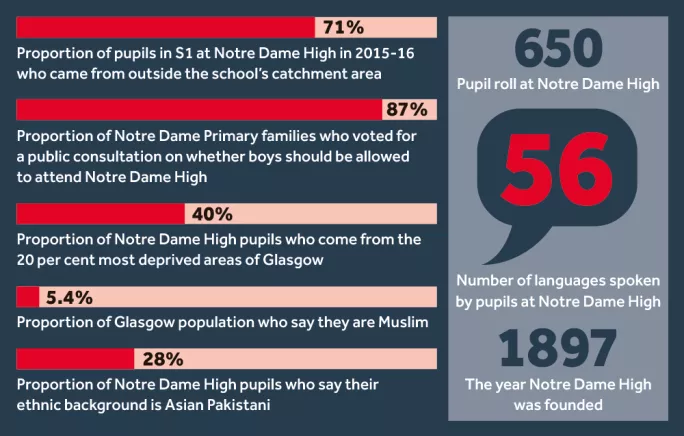The all-girls school under pressure to mix things up

Notre Dame secondary - the only all-girls state school in Scotland - is situated in Glasgow’s West End. Not far from trendy Byres Road, it is tucked away among quiet residential streets lined with rather grand sandstone tenements.
The 650 girls who attend Notre Dame High are drawn from all over the city and sometimes beyond. Single-sex schools are often highly selective, but headteacher Rosemary Martin explains that, while the school is located in one of the most affluent areas of Glasgow, 40 per cent of its pupils come from the most deprived parts of the city.
Depute head Joe Kane has just plotted where the pupils in five of the school’s six year groups come from: there are pin heads dotted all over his map of the city. Asmaa Zaki, an S5 pupil, has a 40-minute car ride into school every morning, travelling from Stepps in North Lanarkshire. Other girls come from Cumbernauld and Coatbridge, and then there are girls like S4 pupils Teresa Richter and Niamh Fraser, who live within walking distance.
The girls who come here say they like the atmosphere at Notre Dame High. They can concentrate better without boys around. Even the school prom is a girls-only affair.
History teacher Kelly McBride arrived at the school in August after teaching in other Glasgow secondaries. She comments on “the massive difference in behaviour management”. “The girls are so much more focused,” says Ms McBride. “They come and they want to do well. There just aren’t the same level of interruptions you have in a mixed school.”
She was also struck by the difference at her first school disco. “All the girls were really enjoying themselves - they had no inhibitions. Normally there would be a stand-off about who is going to dance first, but they were just really confident and mixed well.”
You learn much faster without boys being around, says Teresa Richter, who joined the school in S1 from a co-educational school in Germany. “Also, when you are with all girls you can always find someone to be with, which is quite nice,” she adds.

For Teresa’s family, it was not the school’s girls-only status that appealed - her mother just liked the feel of the place. For other girls and their families, however, it is vitally important. In Islam, education is compulsory for children but socialising and mixing with the opposite gender is discouraged, says Fatima Khokhar, who has just entered S6. That’s why her family opted to send her to Notre Dame. “My dad thought if I came to a girls’ school I could practise my religion and not go against it,” she explains. Some 1.4 per cent of Scots are Muslim, but that proportion rises to 5.4 per cent in Glasgow. There is one private Muslim primary school in the city - the only Muslim school in Scotland.
This lack of Muslim faith schools means that Scottish Muslim families often opt to send their children to Catholic schools so they benefit from the religious ethos. They do not record the religion of pupils at Notre Dame High, but 28 per cent of the girls report their ethnic background as Asian Pakistani.
The question of whether Notre Dame should remain a girls-only school has recently been raised by parents at one of its associate primaries, the mixed Notre Dame Primary.
Jill Grady has a daughter in P1 at the school and a son in nursery, and so faces the prospect of the children being split up when they start secondary, with her daughter attending Notre Dame High and her son St Thomas Aquinas.
She says that she did not realise that by opting for the local Catholic school she would be set on a “denominational track”. Her local non-denominational secondary - Hyndland - is closed to her unless she successfully manages to make a placing request into the school.
She doesn’t want to take the chance: schools in the West End are filling up fast, she says. As a working parent, she does not relish the prospect of two drop-offs. Notre Dame High is within walking distance of her home but St Thomas Aquinas is a car journey away.
Ms Grady says: “People might argue that I should have done my research, but the first time you send a child to school you learn a lot. If I had known what I know now, I don’t know if I would have sent my daughter to Notre Dame Primary. She loves it but if we are not successful [in making Notre Dame High co-educational] the result is going to be a huge amount of upheaval, and a lot of parents feel that way.”
In a ballot at Notre Dame Primary in March, which around 70 per cent of families participated in, 87 per cent voted in favour of a public consultation on whether boys should be admitted to Notre Dame High.

The main arguments for changing the status of the school are that, under the current arrangements, peer groups do not get to transition to secondary school together; siblings are split up; and while St Thomas Aquinas provides “an excellent environment for children”, it is further away and not at the heart of the local school community.
However, Glasgow City Council has made it clear that while it is listening, “any changes would affect parents from a number of schools and the views of all must be considered”.
Notre Dame High pupils - predictably, perhaps - say they like the school the way it is, although academic Emer Smyth, who has carried out a review of the research into single-sex education, says young people generally say they prefer co-ed when asked.
Headteacher Ms Martin says she has told the girls it is business as usual, but says she appreciates why some might like to see the school’s status change. “I can understand the parents because, at the end of the day, your child’s education is of paramount importance. It’s understandable that some of them might find it frustrating that our school is 10 minutes up the road and their son is not allowed to go here, so they have to go further.”
Ms Martin arrived at Notre Dame High 20 years ago as an assistant principal teacher of pastoral care and rose through the ranks, eventually taking over as headteacher three years ago. The confidence of the girls struck her when she arrived, she says.
“There’s a lack of inhibition when girls are on their own,” she explains. “There is less pressure to be something other people see you as being, or expect you to be.”
Does it bother her that the school could become co-educational? “My role is to achieve the best outcomes for the young people that come to Notre Dame - that’s my mantra. That’s what I’m here for,” she says.

And the school is thriving, says Ms Martin. A few years ago it was struggling to break through the 10 per cent barrier when it came to the proportion of pupils achieving five Highers, but last year 22.9 per cent did.
There is a strong focus on science, technology, engineering and maths; the school has recently reintroduced computing. Mr Kane offered a crash Higher to S6 pupils for the first time in 2014-15, and this year the subject was available at N4, N5 and Higher. A computing probationer will join the school in 2017-18, enabling it to expand the subject further.
The girls are ambitious - they want to be lawyers, engineers, primary teachers, educational psychologists, graphic designers. But how well do they think they will adapt to the mixed environment of a university? S4 pupil Niamh Fraser says: “I don’t think there will be much of a difference when we move up. It will just be like going from primary to an all-girls secondary. It’s just a sector shift, and a change in the type of people you meet.”
Depending on the appetite for change among parents in the area - the parents at Notre Dame High among them - this kind of transition could come sooner than the girls think, heralding the end of an era for the school that stretches back to when it was founded by the Sisters of Notre Dame in 1897.
Thirteen-year-old Teresa, however, points out that there is one indisputable downside to girls-only education: “There can be a lot of gossip when it comes to girls.”
You need a Tes subscription to read this article
Subscribe now to read this article and get other subscriber-only content:
- Unlimited access to all Tes magazine content
- Exclusive subscriber-only stories
- Award-winning email newsletters
Already a subscriber? Log in
You need a subscription to read this article
Subscribe now to read this article and get other subscriber-only content, including:
- Unlimited access to all Tes magazine content
- Exclusive subscriber-only stories
- Award-winning email newsletters